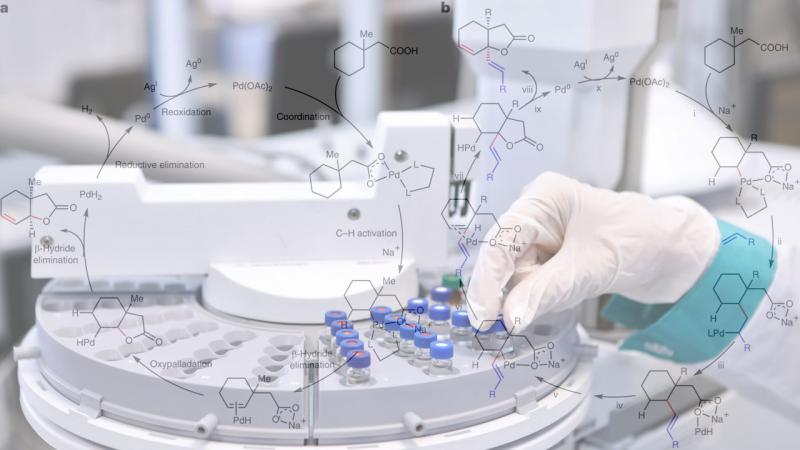
Scientists from the Indian Institute of Technology Bombay (IIT Bombay) have made a major breakthrough in synthetic organic chemistry. They have successfully developed a reaction which activates unreactive carbon-hydrogen (C-H) bonds to form essential compounds called lactones found in natural products and pharmaceuticals. This new method developed by Prof. Debabrata Maiti’s research group at the Chemistry Department, IIT Bombay allows for the selective activation of remote C–H bonds which then results in the formation of not just lactones, but bicyclic lactones (lactones with two rings of atoms).
Lactones, particularly bicyclic lactones, are naturally occurring substances with numerous biological activities that have intrigued synthetic chemists for decades. These lactones have been traditionally used in the treatment of bacterial infections and inflammations such as dermatitis, eczema, acne, eye infections, pneumonia, and stomach ailments.
“They have therapeutic properties and are being studied for their potential in drug development” explains Dr. Jayabrata Das, a former doctoral researcher at Prof. Maiti’s group.
There are several existing methods to produce lactones, but these often involve several hurdles. They usually require complex starting materials that are not readily available and instead, have to be first produced. They also generally involve several steps, involving several intermediate reactions, to finally generate the lactones. The process of converting largely unreactive C-H bonds into useful functionalities often presents challenges unless a directing group, which could be a part of a molecule that facilitates the reaction, is involved. Synthetic chemists have been probing for a simple single-step reaction that could produce lactones and bicyclic lactones.
In their study, now published in Nature Chemistry, the researchers hypothesised a new method that goes against the convention. They used alkyl carboxylic acids as substrates and activated these with the help of a transition metal as the catalyst. Carboxylic acids are organic acids that contain a carboxylic group and a substituent or R group, with the general formula R-COOH, like acetic acid (CH3COOH) or formic acid (HCOOH). Here, the R group determines whether the carboxylic acid is alkyl, alkylene or aryl. For their experiment, the researchers used 3-methyl cyclohexane acetic acid, an alkyl carboxylic acid, as the substrate and palladium (Pd) as the catalyst. The acid contains a methyl group, which has one carbon atom attached to 3 hydrogen atoms (CH3), and a methylene group, which contains 2 hydrogen atoms attached to a single carbon atom (CH2).
Conventional knowledge suggests that, due to their molecular structures, methyl group activation (breakage) is easier than methylene. But the researchers hypothesised that the opposite might be the case in their reaction. The reason – a phenomenon called reverse site selectivity.
“Reverse site selectivity is when we observe the opposite of what the conventional selectivity pattern is. In this case, it is methylene activation in the presence of methyl. Our research finds that we can selectively activate the methylene group keeping the methyl group intact,” explains Prof. Maiti.
“The rationale for reverse selectivity lies in the reaction pathway that methyl vs methylene activation takes. Although methyl activation initially is easier than methylene, the subsequent elementary steps are difficult. However, methylene activation, although more strenuous than methyl, has subsequent steps that are thermodynamically favourable,” he adds.
The reverse site selectivity allows for the unreactive C-H bonds of the methylene to activate, and thus form lactones.
They went on to test the reaction with several other classes of substrates. They chose aliphatic acids, which are organic hydrocarbons with 5, 6, 7, 12 and 15 membered ring structures. The theory seemed to hold, and the reaction was successful in producing lactones, albeit in different quantities, thus confirming their hypothesis. Next, the researchers performed the reaction in the presence of other external chemicals, like olefin or allyl alcohol. They were intrigued to find that the reaction produced more complex forms of lactones, like unsaturated lactones containing olefins.
“One of the long-standing goals of synthetic chemists is to make more complex compounds from simpler starting materials, ideally in a single step. This reaction shows the potential of such approaches,” remarks Dr. Das.
The research not only allows for a simpler method to produce biologically and pharmaceutically important molecules like lactones but also presents an elegant way to create more complex molecules. The reverse site selectivity demonstrated through this reaction could help unlock several new exciting reactions, in the process helping in the production of new and important chemicals or reducing the steps involved in producing them.
“More importantly, it demonstrates the complexities of molecules and their chemical interactions and reveals the process of understanding and exploring one new reaction at a time,” remarks Prof. Maiti.






